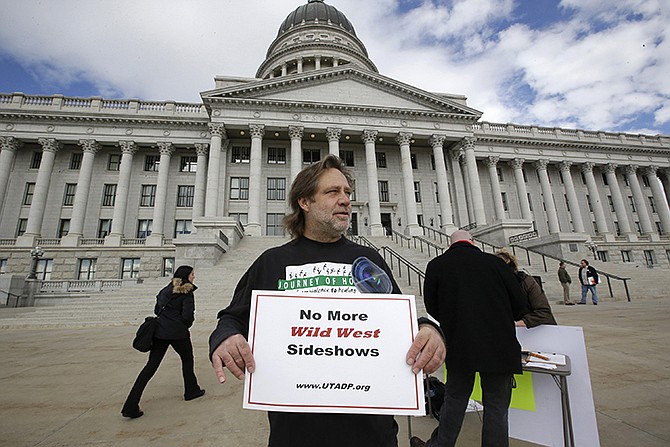SALT LAKE CITY (AP) - A hotly contested proposal that resurrects Utah's use of firing squads to carry out executions narrowly passed a key vote Friday in the state's Legislature after three missing lawmakers were summoned to break a tie vote.
The Republican-controlled House of Representatives voted 39-34 Friday morning to approve the measure, sending it to an uncertain fate in the state's GOP-controlled Senate. Leaders in that chamber have thus far declined to say if they'll support it, and Utah's Republican Gov. Gary Herbert won't say if he'll sign it.
Senate President Wayne Niederhauser, a Republican from Sandy, again declined to tell reporters on Friday if he'd support it.
Rep. Paul Ray, a Republican from Clearfield who is sponsoring the measure, said after the vote Friday he thinks it will be just as close in the Senate, and he hasn't started trying to press his case in that chamber.
Lawmakers in House of Representatives initially voted 35-35 on the proposal Friday morning. But Ray asked for three missing lawmakers to be summoned to the floor, where they all voted in favor.
During that time, Riverton Republican Rep. Dan McCay switched to vote in favor, allowing the measure to pass 39-34. When asked later by the Associated Press about the switch, McCay smiled and walked away without commenting.
Ray argues a team of trained marksmen is faster and more humane than the drawn-out deaths that have occurred in botched lethal injections. His bill would call for a firing squad if Utah cannot get lethal injection drugs 30 days before an execution.
Critics say the firing squad is a gruesome relic of Utah's Wild West past and would bring international condemnation upon the state. That criticism and excessive media attention was one of the reasons many lawmakers voted in 2004 to stop allowing condemned prisoners to choose death by firing squad.
A handful of inmates on Utah's death row were sentenced before the law changed and still have the option of going before a firing squad in a few years once they have exhausted any appeals. It was last used in 2010 when Ronnie Lee Gardner was executed by five police officers with .30-caliber Winchester rifles.
For years, states used a three-drug combination to execute inmates. But European drug makers have refused to sell the drugs to prisons and corrections departments out of opposition to the death penalty.
Drug shortages and troubles with administering lethal injections have led several states to begin revisiting alternatives during the past year
A bill to allow firing squad executions is working its way through Wyoming's Legislature, while lawmakers in Oklahoma are considering legislation that would allow that state to use nitrogen gas to execute inmates.
Ray has argued the firing squad is the fastest, most reliable method and the most humane way to kill someone.
The Washington, D.C.-based Death Penalty Information Center, which opposes capital punishment, says that a firing squad is not a foolproof method because the inmate could move or shooters could miss the heart, causing a slower, more painful death. One such case appears to have happened in Utah's territorial days back in 1879, when a firing squad missed Wallace Wilkerson's heart and it took him 27 minutes to die, according to newspaper accounts.

